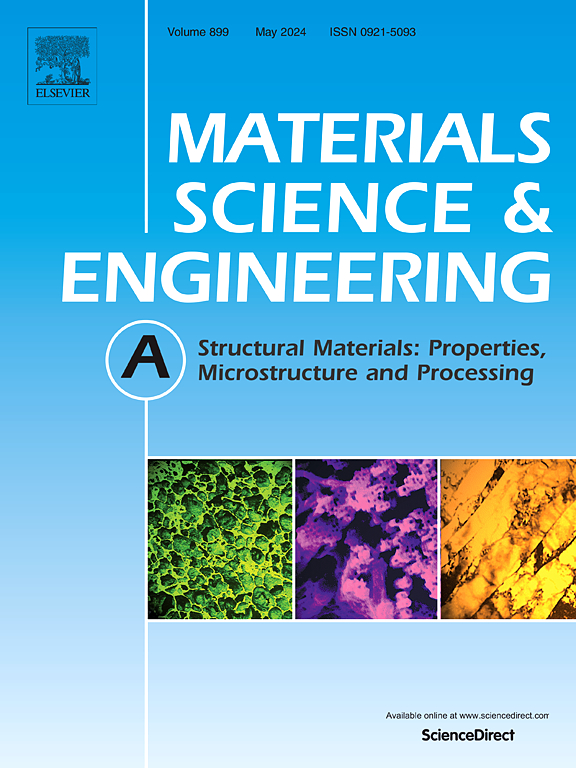Effect of cooling rate on microstructure and mechanical properties of AlMo0.5NbTa0.5TiZr refractory high-entropy alloy prepared by laser metal deposition
IF 7
2区 材料科学
Q1 MATERIALS SCIENCE, MULTIDISCIPLINARY
引用次数: 0
Abstract
AlMo0.5NbTa0.5TiZr is a novel lightweight refractory high-entropy alloy (RHEA) with a unique B2/BCC dual-phase structure. It exhibits excellent high-temperature mechanical properties while maintaining a low density, making it highly promising for aerospace applications. In this study, AlMo0.5NbTa0.5TiZr RHEAs are prepared by laser metal deposition (LMD). The effect of cooling rates at different temperatures on the microstructure and mechanical properties of LMD-formed AlMo0.5NbTa0.5TiZr after homogenization is investigated for the first time. This study highlights the formation of basket-weave structure, the competitive precipitation behavior of Al-Zr phases, and the strengthening mechanism. The LMD-formed specimens consist of columnar and cellular dendrites, which transform into equiaxed grains with a basket-weave structure after homogenization. At 1200 °C, a high density of Al3Zr4 point-like phases form, increasing as the cooling rate decreases. In the 1400 °C specimens, numerous blocky precipitates appear, and the size gradually increases with the decrease of the cooling rate. Additionally, the basket-weave structure is only formed in the 1400 °C furnace-cooled specimen, indicating that high cooling rate or low heat treatment temperature will inhibit the formation of the basket-weave structure. The 1400 °C air-cooled specimen exhibits a higher microhardness of 668 HV and compressive strength of 2314.7 MPa due to grain refinement and the precipitation of the hard Al4Zr5 strengthening phase. The specimen treated at 1200 °C exhibits a significant decrease in microhardness and compressive strength, due to the disappearance of the B2 phase caused by the precipitation of point-like Al3Zr4 phases. This study provides a foundation for optimizing the microstructure regulation of AlMo0.5NbTa0.5TiZr RHEAs.
冷却速率对激光金属沉积AlMo0.5NbTa0.5TiZr耐火高熵合金组织和力学性能的影响
AlMo0.5NbTa0.5TiZr是一种新型轻质耐火高熵合金(RHEA),具有独特的B2/BCC双相结构。它具有优异的高温机械性能,同时保持低密度,使其在航空航天应用中非常有前途。本研究采用激光金属沉积(LMD)法制备了AlMo0.5NbTa0.5TiZr RHEAs。首次研究了不同温度下的冷却速率对均匀化后lmd成形的AlMo0.5NbTa0.5TiZr显微组织和力学性能的影响。本文重点研究了篮织结构的形成、Al-Zr相的竞争析出行为及其强化机理。lmd形成的试样由柱状和胞状枝晶组成,均质后转变为篮织结构的等轴晶。在1200℃时,形成高密度的Al3Zr4点状相,随着冷却速率的降低而增加。在1400℃试样中,出现大量块状析出,且随着冷却速率的降低,尺寸逐渐增大。此外,只有在1400℃的炉冷试样中才会形成篮织组织,说明高冷却速度或低热处理温度会抑制篮织组织的形成。在1400℃风冷时,由于晶粒细化和硬Al4Zr5强化相的析出,试样的显微硬度达到668 HV,抗压强度达到2314.7 MPa。1200℃热处理后,由于点状Al3Zr4相析出,B2相消失,试样的显微硬度和抗压强度显著降低。本研究为优化AlMo0.5NbTa0.5TiZr RHEAs的微观结构调控提供了基础。
本文章由计算机程序翻译,如有差异,请以英文原文为准。
求助全文
约1分钟内获得全文
求助全文
来源期刊

Materials Science and Engineering: A
工程技术-材料科学:综合
CiteScore
11.50
自引率
15.60%
发文量
1811
审稿时长
31 days
期刊介绍:
Materials Science and Engineering A provides an international medium for the publication of theoretical and experimental studies related to the load-bearing capacity of materials as influenced by their basic properties, processing history, microstructure and operating environment. Appropriate submissions to Materials Science and Engineering A should include scientific and/or engineering factors which affect the microstructure - strength relationships of materials and report the changes to mechanical behavior.
 求助内容:
求助内容: 应助结果提醒方式:
应助结果提醒方式:


